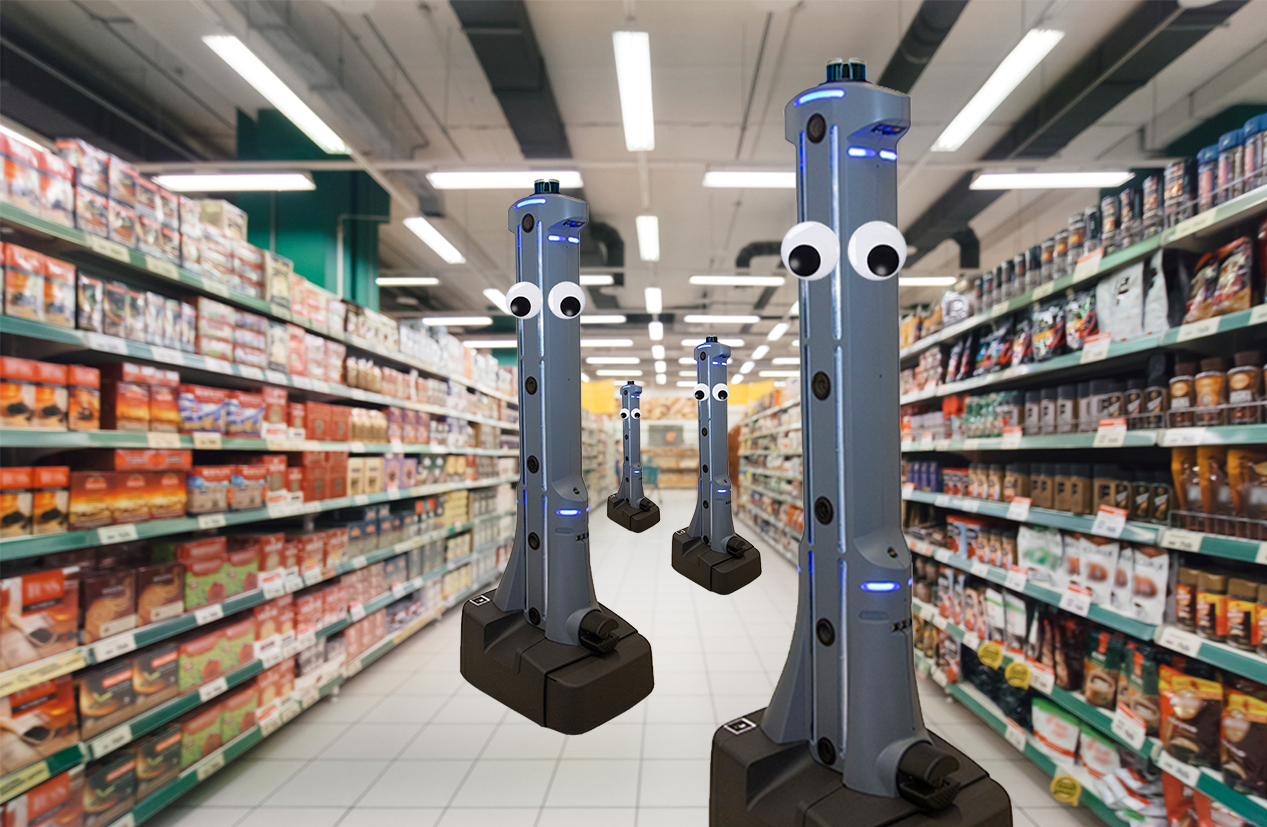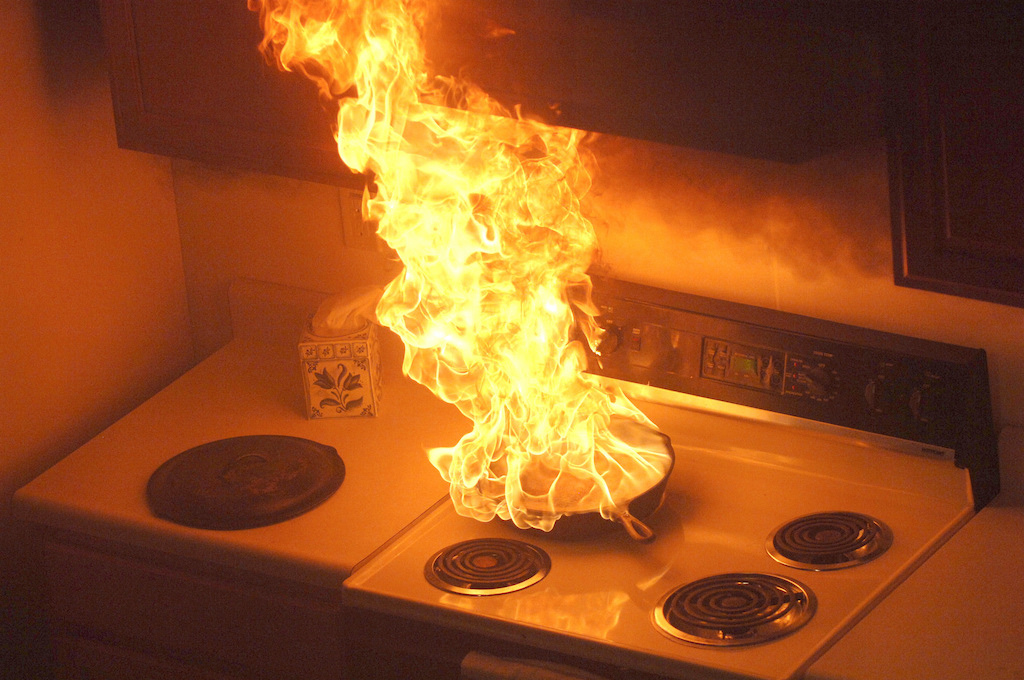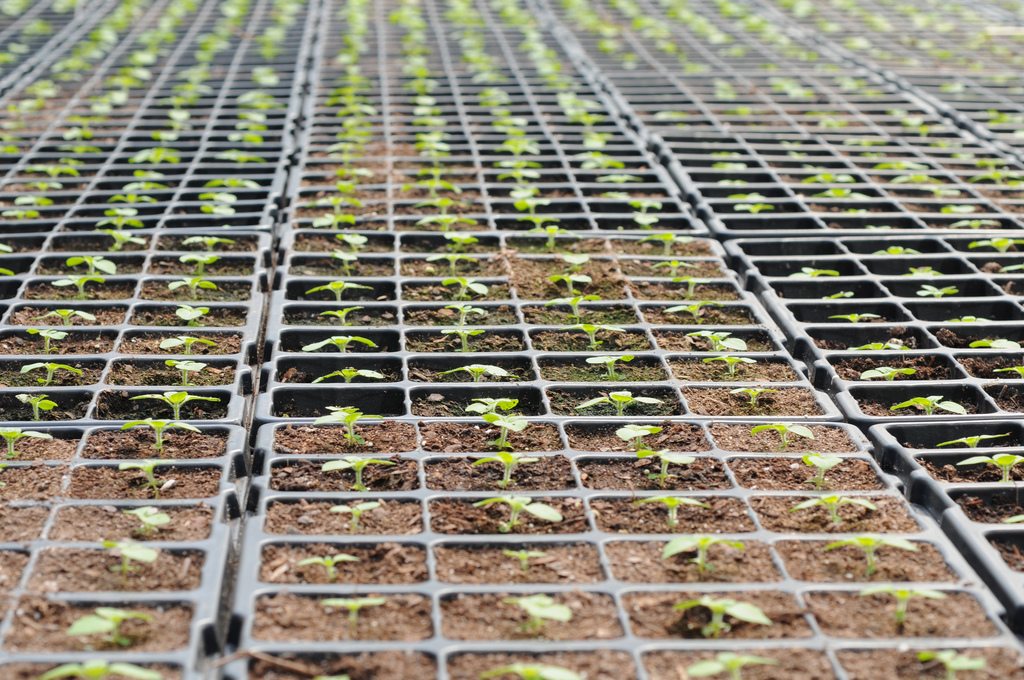
Badger Technologies; Fascinadora / iStock
I met Marty in the produce section of a Stop & Shop in Bristol, Rhode Island. I was looking for vegetables to grill over hot coals, while Marty roamed the aisles, big, round eyes staring vacantly ahead, searching for spills and other hazards—with electric sensors strategically placed on its tall, rectangular form. Marty, you see, is a supermarket robot.
Since January, the northeastern supermarket chain Stop & Shop has introduced more than 200 robots to stores in Massachusetts, Connecticut, Rhode Island, and New Jersey. This month the company will begin rolling Marty out to stores in New York. By the end of the year, there will be more than 300 robots in Stop & Shop stores and nearly 200 more in Giant stores, another supermarket chain owned by the Netherlands-based parent company, Ahold Delhaize.
Marty is at the vanguard of the robot revolution, normalizing automation in everyday spaces. Stop & Shop is not alone in this; Walmart is planning on introducing autonomous floor scrubbers to 1,860 stores by next February. But Marty’s introduction to supermarket floors has raised a number of questions about automation and surveillance for employees and customers alike—especially because the robot roll-out roughly coincided with a widespread Stop & Shop labor strike this spring to protest unfavorable changes to union contracts. Meanwhile, customers have taken to Twitter to complain that the robot is “creepy” and wonder if it is watching them.
 Giant Food Stores
Giant Food Stores Marty, a robot assistant, roams the aisles of a Giant Food Store
In the days leading up to Passover and Easter, more than 30,000 Stop & Shop workers went on strike for 11 days, costing the company between $90 and $110 million, Labor Notes reported, or around 3 percent of their annual profit. Kristen, a Stop & Shop employee and union member, pointed out the irony of a company telling its workers how broke it was (even though Ahold Delhaize reported more than $2 billion in profits last year) while forking over a reported $35,000 per robot. She said many stores have cut back on staffing in the past few years, and now employees are responsible for jobs previously held by multiple people.
Although Jennifer Brogan, Stop & Shop’s director of external communications, assured New Food Economy that the robot is not meant to replace workers, Ahold Delieze has explicitly told shareholders that the company is investing in automation and artificial intelligence to supplement or even replace human labor.
In its 2018 annual report, the company identified organized labor as a potential risk to the company: “Our brands may not be able to negotiate acceptable terms for extensions and replacements of contracts as a result of unfavorable demands and expectations from unions.”
But, as Ahold Delieze reassured shareholders, the company is working on the problem: “We are partnering on technologies that are not only helping us make the customer experience even more personal and relevant but also operate more efficiently and manage labor shortages in our markets. This includes exciting new collaborations in artificial intelligence and robotics.”
Exciting may be in the eye of the beholder.
Marty has just one job: The robot moves around the store and when it encounters a spill or a loose item on the floor, it alerts the staff to come clean it up using the PA system. That’s it. That’s all. What’s worse is that Stop & Shop employees say the robot can’t even do that well.
“Today [Marty] called for cleanup because it detected something on the floor,” one Stop & Shop employee told New Food Economy. “The ‘something’ was someone’s cart. It will stop for anything it detects on the floor, even a twist-tie from produce, and someone has to go pick it up or the robot will keep announcing the need for a cleanup.”
“It’s really not doing much of anything besides getting in the way,” said Kristen. She complained that the robot pages the store nearly constantly, over the smallest things—like a stem from a bunch of grapes—and it will go around in circles until an employee comes to clean the “hazard” up. “Right now he’s a glorified Roomba and he doesn’t even vacuum.”
Stop & Shop’s official line on the worker-robot tension, shared with concerned customers on Twitter and reiterated by Brogan to New Food Economy, is that Marty frees associates to spend more time with customers. Also, Marty supposedly can’t be meant to replace workers because he “doesn’t even do the clean-up.”
Brogan also told New Food Economy that the company has no plans to expand Marty’s responsibilities. But Kristen said the managers at her store have already informed employees that they eventually want the robot to scan shelves to look for out-of-stock items and price disparities, something the robot is already programmed to do. (Tim Rowland, the CEO of Badger Technologies, the company that manufactures Marty, has further described the robots’ capabilities.)
 Badger Technologies
Badger Technologies Graphic rendering of a robot now found at hundreds of grocery stores across the country
If Kristen’s managers were not mistaken, it raises a question about why Stop & Shop is misleading the press and their customers about what the robot can and can’t do, or will or won’t do. This aggravates a situation in which customers are already disconcerted by the robot—I certainly got the creeps seeing it roam around the Bristol store, especially when it invaded my personal space—and don’t fully understand what it is doing.
Charise Thomson, a Stop & Shop customer who first encountered Marty at a store in Dorchester, Mass., said the robot appeared without any advance notification.
“I was kinda surprised by it,” Thomson told New Food Economy. On Twitter, she wrote, “I saw a real live robot in Stop & Shop cleaning up and catching people stealing and shit yesterday.”
Brogan says Marty doesn’t have anything to do with shoplifting, and reiterated that its only job is to scan the floors for hazards. However, the robot is decorated with two cartoonish plastic googly eyes, so customers might be forgiven for assuming they are being watched. And indeed, that might be an intentional choice.
Studies have suggested that simply incorporating eyes into a sign or poster can deter criminal behavior like theft or littering.
A sticker—shaped like a grin and positioned beneath the two eyes—briefly explains what Marty does, but does not address potential privacy concerns: “This store is monitored by Marty for your safety,” the message begins, vaguely. “Marty is an autonomous robot that uses image capturing technology to report spills, debris and other potential hazards to store employees to improve your shopping experience.”
When asked about Stop & Shop’s policy for dealing with the photographs or videos of customers that Marty captures, Brogan said that they are “stored for a very short period of time and then destroyed.” It is unclear exactly how they are stored, for exactly how long, or who has access to them. This leaves customers and employees in the dark, unsure if they are being watched or not.
In light of reports of other stores testing cameras that try to guess customers’ age and gender, shoppers have reason to worry.
“I don’t think it was following people around or anything but I don’t know what it’s doing, it’s just there,” Thomson said. “I would like to have more information.”
Of course, all of this is only relevant if the machine is up and running; one worker said the Marty delivered to their store didn’t work and had to be sent back for repairs, and has only been back on the floor for a day. Another said the robot is currently broken and stored on the charging dock, a $35,000 decoration.
When one considers what Marty actually does against the creepy factor for shoppers, and how much employees seem to dislike it, the question that remains is whether robots are really worth it.










